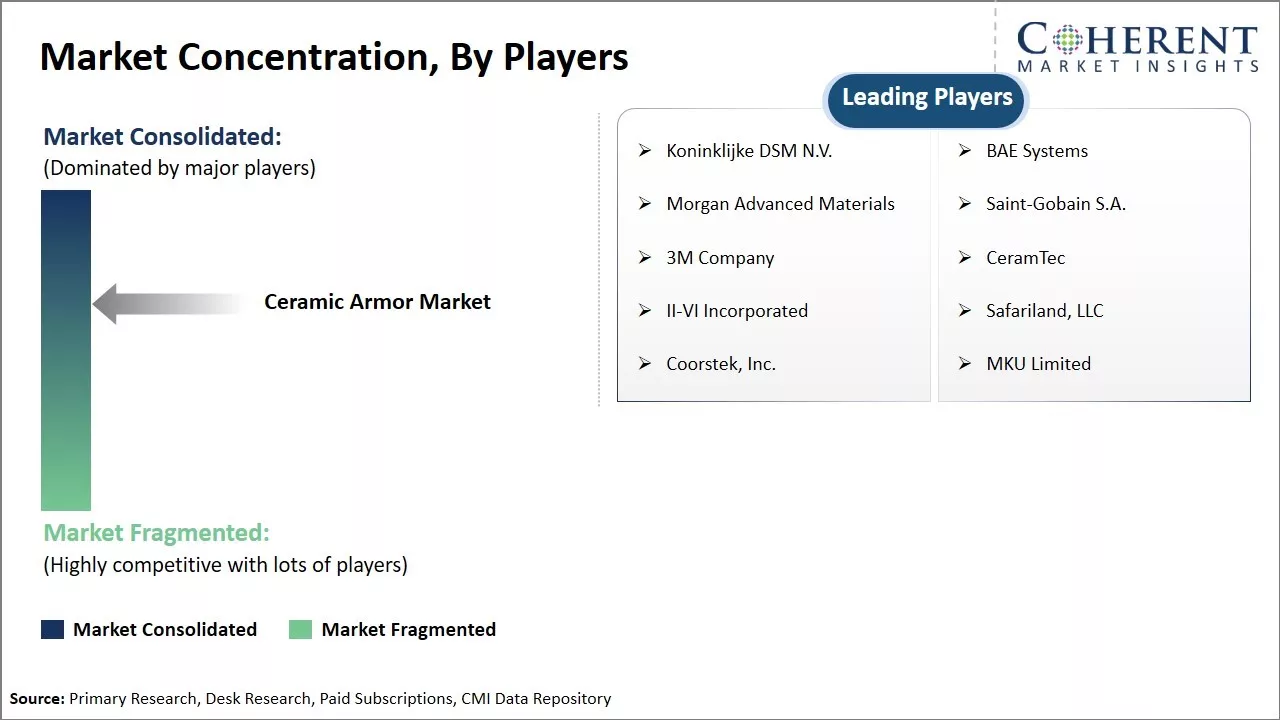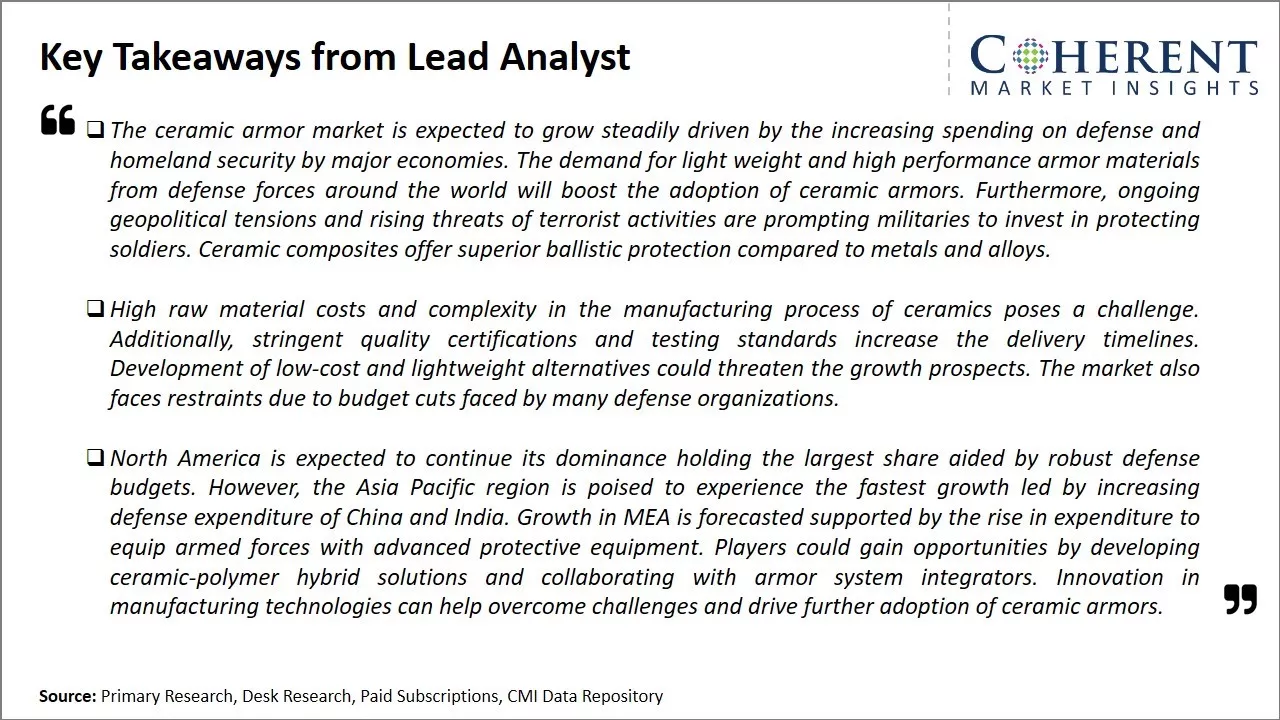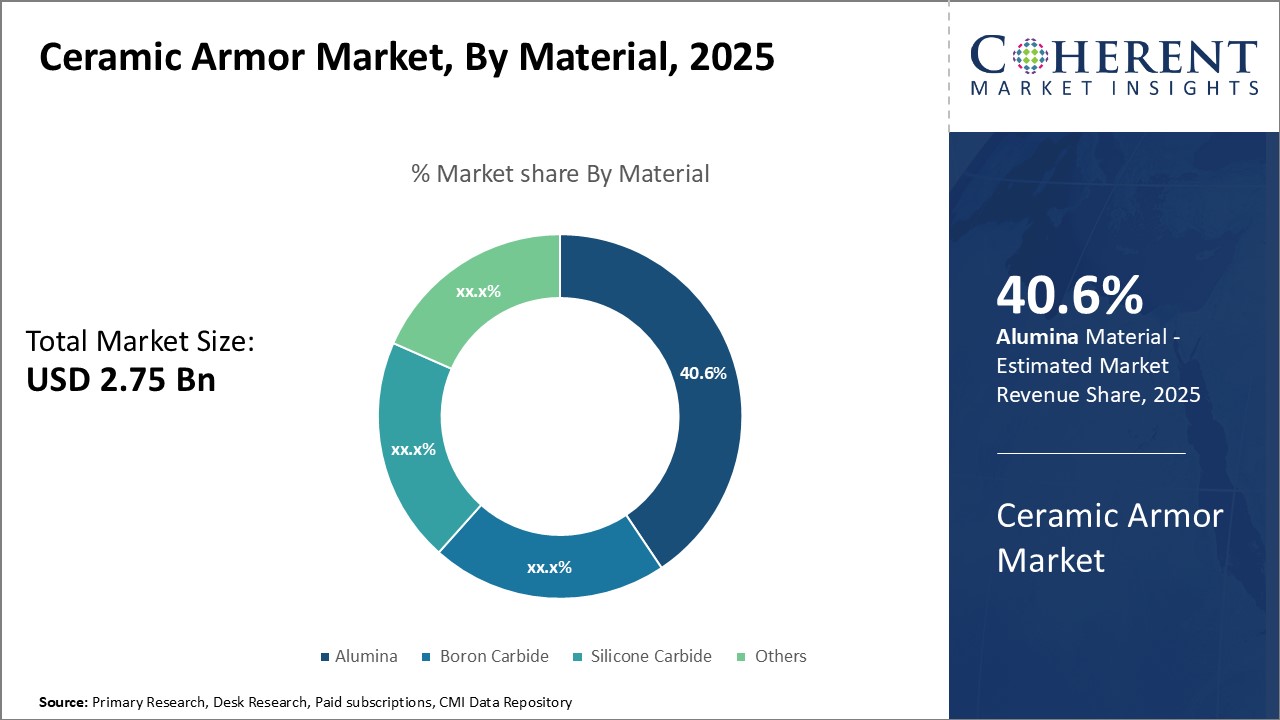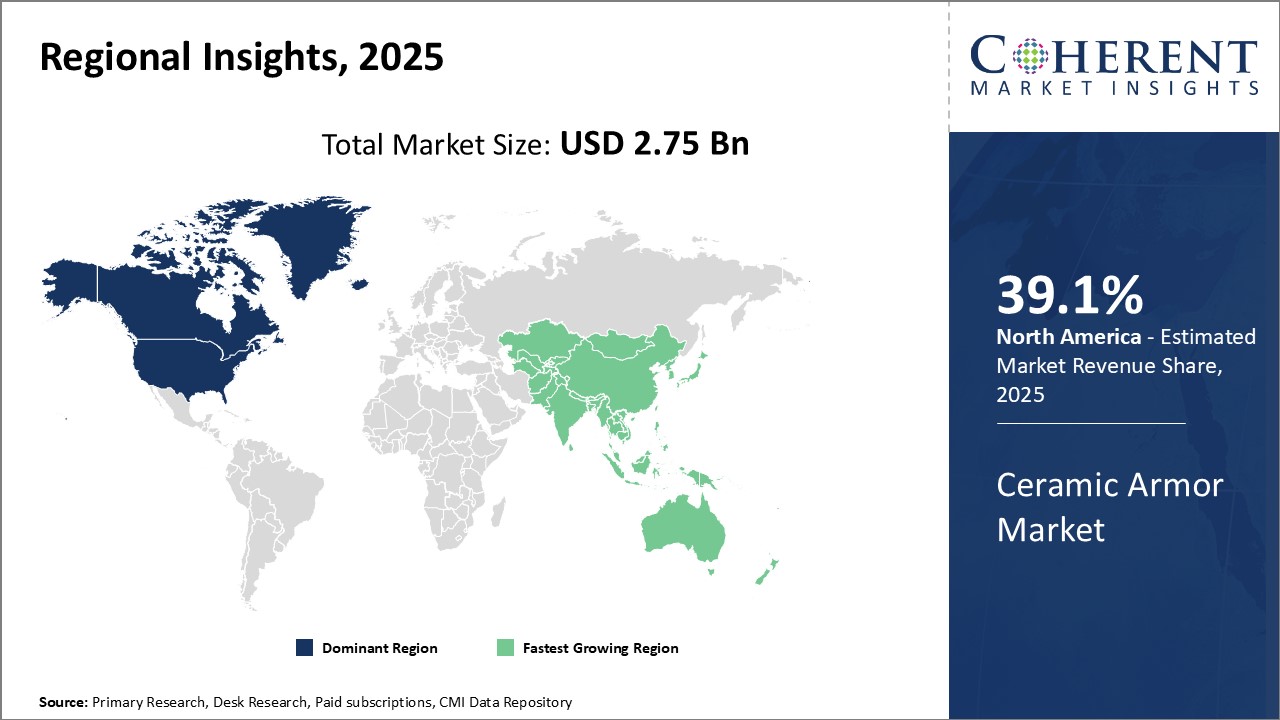Ceramic Armor Market Size and Trends
The global ceramic armor market is estimated to be valued at USD 2.75 Bn in 2025 and is expected to reach USD 4.08 Bn by 2032, growing at a compound annual growth rate (CAGR) of 5.8% from 2025 to 2032.

Discover market dynamics shaping the industry: Download Free Sample
The ceramic armor market is expected to witness significant growth over the forecast period. Technological advancements in lightweight and durable ceramic materials are fueling the demand for ceramic armor among defense and military agencies. Growing geopolitical tensions and rising defense budgets of countries across North America, Europe, and Asia Pacific are also driving the adoption of advanced protective equipment like ceramic armors. Additionally, increasing incidences of violent conflicts and cross border tensions have enhanced the requirement for personal security and safety applications which is further propelling the ceramic armor market growth globally.
Commercial Security Personnel Mandate Body Armor Use
Aside from military needs, another key element boosting ceramic armor demands pertains to regulations compelling security personnel in high-risk occupations to wear protective apparel. The rapid growth of private security companies worldwide to meet escalating safety and law enforcement requirements across various sectors has amplified this commercial dimension of the market. Many firms overseeing cash-in-transit, critical infrastructure surveillance, and special event security now mandate the deployment of armor-wear certified to certain safety standards.
Additionally, rising instances of active shooter incidents especially in North America have boosted the demand for ceramic armors. For instance, on April 26, 2023, the Federal Bureau of Investigation (FBI) designated 50 shootings in 2022 as active shooter incidents.
By making personnel donning of hard armor a requirement, organizations aim to uphold duty of care while minimizing operational disruptions from casualties. This pushes suppliers to broaden their commercial portfolio aligned with industry expectations.
Market Concentration and Competitive Landscape

Get actionable strategies to beat competition: Download Free Sample
Military Spending on Body Armor will Stimulate Market GrowthAs geopolitical conflicts continue to intensify across different parts of the world, more countries are allocating higher military budgets for procuring improved personal protective equipment including advanced ceramic armor systems for their troops. For instance, according to the data published by the U.S. Department of Defense, in April 2022, the defense budget was USD 703.7 Bn in 2021 and 742.3 Bn in 2022. Nations involved in counterinsurgency and counterterrorism operations especially recognize the need to safeguard soldiers engaged in combat against lethal ballistics and explosive threats. Lightweight but highly durable ceramic armor plates provide reliable protection against a wide range of ammunition without compromising on mobility. With ceramic materials undergoing constant refinement to block penetrations more effectively at lower weights, defense agencies see value in frequent upgrades of armor solutions. Manufacturers are accordingly engaged in new product innovations and customizing offerings as per customer requirements to benefit from rising defense expenditures devoted to soldier modernization with cutting-edge survivability gear. Additionally, greater usage of private military contractors in overseas deployments also contributes to the broadening market scope. With combat scenarios becoming more complex, there is diminished reluctance to spend substantially on battlefield protection technologies that can save lives.

To learn more about this report, Download Free Sample
Market Challenges: High Production CostThe global ceramic armor market faces several challenges. Ceramic materials used for armors are still quite heavy, limiting soldier mobility flexibility on the battlefield. Production costs remain higher than alternative armor materials like metals. Innovation in ceramic formulations to improve ballistic protection capabilities while reducing weight and expenses is an ongoing challenge. Environmental regulations have made some raw materials more expensive. Dependence on a small number of suppliers for critical materials can threaten supply security.
Market Opportunities: Ongoing Conflicts and Rising Defense Budgets
However, the market also presents various opportunities. Ongoing conflicts and rising defense budgets are driving the demand for superior body armor. For instance, according to data published by the Press Information Bureau (PIB), the nodal agency of the government of India, on February 1, 2023, the Ministry of Defense was allocated a total budget of USD 71.50 Bn, which was 13.18 % of the total budget. Lightweight ceramics with multi-hit capabilities could see wider adoption. Integration of ceramics into vehicle armor and new application areas like maritime security expands the addressable market. Advances in engineering and additive manufacturing may enable cost reductions. Deeper collaboration with materials suppliers ensures reliable raw material access.

Discover high revenue pocket segments and roadmap to it: Download Free Sample
Insights, By Material: Number of uses of alumina in ceramic armorThe material segment in the global ceramic armor market is currently dominated by alumina with a market share 40.6%. Alumina ceramic materials have been used in armor applications for decades due to their high hardness, strength, and damage tolerance. According to tests conducted by the U.S. Defense Department, alumina ceramic plates are able to stop multiple armor-piercing bullets and fragments. This superior ballistic resistance of alumina is credited to its high density, which packs ceramic atoms tightly together to disrupt the kinetic energy of incoming projectiles. Additionally, alumina is one of the most inexpensive ceramic materials to produce at scale. Established manufacturing processes allow large volumes of alumina armor tiles and panels to be fabricated in a cost-effective manner.
While alumina remains the most widely-used ceramic material in armor, silicon carbide is gaining momentum as the fastest growing segment. Silicon carbide ceramic exhibits even higher hardness than alumina, almost 40% higher density, and superior mechanical properties at elevated temperatures. These attributes make it especially attractive for applications involving high heat and impact exposure. Several military programs are actively investigating silicon carbide composite armors for next-generation body armor, shielding, and vehicle armor systems.
Insights, By Application: Protection needs drive demand for body armor
In terms of application, body armor accounts for the largest share of 35.6% of the global ceramic armor market as it experiences growing demand from military and law enforcement personnel. Ceramic materials play a vital role in modern body armor systems as the first line of defense against bullets, shrapnel and stab injuries. The need to safeguard soldiers and law enforcers against a wide range of lethal threats is the primary factor driving consumption of ceramic-based body armor plates and vests.
Recent conflicts and heightened security risks have prompted defense agencies worldwide to prioritize personnel protection. Meanwhile, new lightweight armor solutions combining advanced ceramics with textiles allow enhanced freedom of movement compared to older protection gear. Such developments expand the utility of body armor for diverse operational requirements on ground. Furthermore, stab resistant and trauma plate inserts using ultra-strong ceramic composites are essential additions to body armor designs. Overall, the critical importance of protecting human lives in the line of duty continues boosting expenditure on advanced body armor featuring optimum ballistics-defeating ceramics.
Insights, By End-user: Escalating defense budgets fuel ceramic armor adoption in defense sector
In terms of end-user, the defense sector accounts for the maximum share of 42.6% of the global ceramic armor market owing to rising defense allocations of major spending nations. Defense agencies procure ceramic composite-based armor solutions for diverse land, naval and airborne platforms. Escalating geopolitical tensions and instability in various regions have driven governments worldwide to strengthen their military abilities through procuring cutting-edge protection technologies. This augurs well for advanced ceramic materials usage in defense applications.
Recent decades have witnessed a continuous increase in global defense budgets among developed and developing countries alike. Major spenders like the U.S., China, and India are aggressively pursuing military modernization programs. This spurs procurement of 5th generation fighter jets, battle tanks, warships and armored vehicles using the latest lightweight ceramic composite panels for multidimensional threat-handling capabilities. Ceramic/polymer matrix composites also find extensive utilization in missile defense interception systems and anti-ballistic defenses requiring extreme hardness and temperature tolerance. In conclusion, the positive outlook of rising defense allocations worldwide portends lucrative prospects for advanced ceramic armor adoption across new defense programs and up-gradation of existing assets. This cements the defense sector’s dominant position as the largest end-user.
Regional Insights

Need a Different Region or Segment? Download Free Sample
North America has emerged as the largest regional market for ceramic armors globally along with a market share of 39.1%. The U.S. contributes significantly to the North American ceramic armor demand given the country's large defense budgets and ongoing engagements in West Asia and other parts of the world. Major Pentagon contracts for advanced personal and vehicle protection systems have led to substantial production and procurement of ceramic components by North American manufacturers in recent years. With defense spending projected to remain high, the region's dominance in the ceramic armor industry is likely to continue.
Another notable market is Asia Pacific which has seen tremendous growth in demand. China has been at the forefront, with its massive military modernization and expansion plans. The Chinese military is procuring new generations of combat vehicles, helicopters and aircraft that require advanced ceramic armor materials for survivability. Several Chinese firms have made big investments in setting up production facilities with technology transfers from European partners. This has enabled China to rapidly boost its self-sufficiency and even emerge as a leading exporter of certain ceramic armor products to other Asian and Middle Eastern countries.
The rapidly evolving security scenarios and modernization of armed forces across South Asian and Southeast Asian countries have stimulated opportunities for foreign original equipment manufacturers (OEMs). Many countries are seeking cost-effective solutions to upgrade the protection levels of their land, air and naval assets. As a result, Asia Pacific has emerged as an attractive production and export base to service regional and extra-regional requirements. While North America currently dominates in terms of demand today, the Asia Pacific market is poised to grow at a much faster pace in the coming years, supported by the industry presence of global as well as local players targeting defense contracts across diverse portfolio.
Market Report Scope
Ceramic Armor Market Report Coverage
| Report Coverage | Details | ||
|---|---|---|---|
| Base Year: | 2024 | Market Size in 2025: | USD 2.75 Bn |
| Historical Data for: | 2020 To 2024 | Forecast Period: | 2025 To 2032 |
| Forecast Period 2025 to 2032 CAGR: | 5.8% | 2032 Value Projection: | USD 4.08 Bn |
| Geographies covered: |
|
||
| Segments covered: |
|
||
| Companies covered: |
Koninklijke DSM N.V., BAE Systems, Morgan Advanced Materials , Saint-Gobain S.A., 3M Company, CeramTec, II-VI Incorporated, Safariland, LLC, Coorstek, Inc., MKU Limited |
||
| Growth Drivers: |
|
||
| Restraints & Challenges: |
|
||
Uncover macros and micros vetted on 75+ parameters: Get instant access to report
Ceramic Armor Industry News
- In July 2022, BAE Systems plc has done a contract with the US Army for Defense Supercomputing Resource Center (DSRC) operations, maintenance, and management services, as well as program-wide services for high-performance computer (HPC) customers
- In January 2022, BAE Systems plc has done a contract with the US Navy to handle its command, control, communications, computers, combat systems, intelligence, surveillance, and reconnaissance (C5ISR) systems
- In May 2022, Koninklijke DSM N.V., a global purpose-led science-based company, announced its agreement to sell its Engineering Materials business to Advent International and LANXESS
*Definition: The global ceramic armor market consists of companies that manufacture ceramic components for armor applications across the military, law enforcement, and commercial sectors worldwide. Ceramic armor uses advanced ceramic materials like boron carbide and silicon carbide to provide ballistic protection from fragments, bullets, and projectiles. It is a lightweight and durable alternative to metal and composite-based armors, and the global ceramic armor market includes manufacturers and suppliers of ceramics, plates, vests, vehicle armor, and others.
Market Segmentation
- Material Insights (Revenue, USD Bn & KT, 2020 - 2032)
- Alumina
- Boron Carbide
- Silicone Carbide
- Others (Aluminum Oxynitride, etc.)
- Application Insights (Revenue, USD Bn & KT, 2020 - 2032)
- Body Armor
- Aircraft Armor
- Marine Armor
- Others (Vehicle Armor, etc.)
- End User Insights (Revenue, USD Bn & KT, 2020 - 2032)
- Defense
- Homeland Security
- Civilians
- Regional Insights (Revenue, USD Bn & KT, 2020 - 2032)
- North America
- U.S.
- Canada
- Latin America
- Brazil
- Argentina
- Mexico
- Rest of Latin America
- Europe
- Germany
- U.K.
- Spain
- France
- Italy
- Russia
- Rest of Europe
- Asia Pacific
- China
- India
- Japan
- Australia
- South Korea
- ASEAN
- Rest of Asia Pacific
- Middle East & Africa
- GCC Countries
- Israel
- Rest of Middle East & Africa
- North America
- Key Players Insights
- Koninklijke DSM N.V.
- BAE Systems
- Morgan Advanced Materials
- Saint-Gobain S.A.
- 3M Company
- CeramTec
- II-VI Incorporated
- Safariland, LLC
- Coorstek, Inc.
- MKU Limited
Share
Share
About Author
Vidyesh Swar is a seasoned Consultant with a diverse background in market research and business consulting. With over 6 years of experience, Vidyesh has established a strong reputation for his proficiency in market estimations, supplier landscape analysis, and market share assessments for tailored research solution. Using his deep industry knowledge and analytical skills, he provides valuable insights and strategic recommendations, enabling clients to make informed decisions and navigate complex business landscapes.
Missing comfort of reading report in your local language? Find your preferred language :
Transform your Strategy with Exclusive Trending Reports :
Frequently Asked Questions
EXISTING CLIENTELE
Joining thousands of companies around the world committed to making the Excellent Business Solutions.
View All Our Clients
